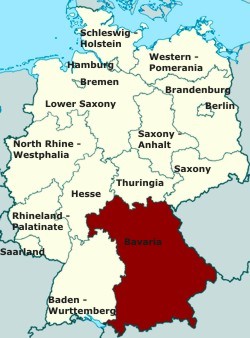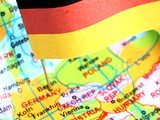Bavaria Germany
a Stereotype Travels Around the World
Bavaria Germany, called Freistaat Bayern, lies in the southeast of the country. By region it is with 70,548 square kilometres the largest of the 16 German federal states. A population of 12.5 million live there and 1.35 million of these live in the state capital Munich.

Borders are shared in the south east with Austriawhere the borderline follows the Alps, the Czech Republic in the east, and Switzerland to the south west. Within Germany Bavaria is located next to Baden Wuerttemberg, Thurigia, Hesse, and Saxony. Two major rivers the Main and the Danube, Donau cross the state.
Patrona Bavariae
The catholic religion dominates Bavaria and the Bavarian protective patron, Patrona Bavariae, is the Virgin Mary, Mother of God. In varied forms statues and paintings of the Virgin Mary is found in chapels and on memorial places throughout Bavaria. One famous statue is positioned at the end of the Theresienwiese in Munich. The place where each year on the second Sunday of the Oktoberfest a brass band concert of all performing bands offer a special highlight.
Bavaria is a versatile state with rural beauty, charming cities, and lots of natural idyll. Be it cruising on the rivers, kayaking streams, walking the Zugspitze, the tallest peak within the Alps on Bavarian ground, or following medieval traces by visiting the castles.
German symbols of Bavaria Germany travel around the world
Strong cultural identity of people born in Bayern, Bavaria Germany endorsed a stereotype to travel around the world. The immediate German cliché that comes to mind are:
- Blue and white lozenges
- People wearing Lederhosen and Dirndl
- Music of brass bands
- Beer, Schweinshaxe with Knoedel or Weisswurst with Sauerkraut and Pretzels with Oabatzda
Blue and white, the colours of Bavaria Germany
The flags of Bavaria show the colours blue and white. One variation displays 21 lozenges ending with a white incomplete lozenge in the upper right corner. The second flag shows two stripes the top one in white and the bottom one in blue. Assumptions about the colours indicate a historical background or reference to the Bavarian anthem and its lines: the colours of your sky blue and white
Lederhosen and Dirndl
Lederhosen and Dirndl are traditional Bavarian clothing called Tracht. Originating in alpine regions they take an important requisite during folk festivities, special occasions, and parades in Bavaria.
Men wear Lederhosen. These are shorts or knickerbockers made of leather often worn with braces. The female Tracht is called Dirndl. It consists of a bodice, blouse, skirt and apron. The materials and colours depend on winter or summer dress, region and occasion. Long sleeved and dark colours dominate the winter the summer is reflected with light colours in cotton or silk and short sleeves.
Brass Bands
Brass bands play to entertain on Bavarian folk festivals. The beer garden and Bavarian beer pub are other common places to hear them. A widely known traditional dance accompanied by the brass band music is the Schuhplattler. Dancers in Lederhosen traditionally danced to attract the woman of their heart. The sound made trough hands clapping on the leather supported the rhythm of the band.
Bavarian food and drink
Bavarian cuisine has a rural background with influences from Austria, Franconia and Swabia. Many traditional dishes include roast or sausage with Knödel and pickled cabbage, red cabbage, or cabbage. Beer is a common drink with the highest average consumption in Bavaria.
A typical beer garden offers a selection on beer, and snacks like Pretzels, Oabatzda, and grilled sausages.
Are you travelling German Cities?
Share your City travel experiences! Personalize your page within German-Cities.com with up to four photos!
 Facts about Germany
Facts about Germany
 Travel Tips
Travel Tips
 Destination Germany
Destination Germany
 Get Around
Get Around
 Find a Hotel
Find a Hotel



New! Comments
Have your say about what you just read! Leave me a comment in the box below.